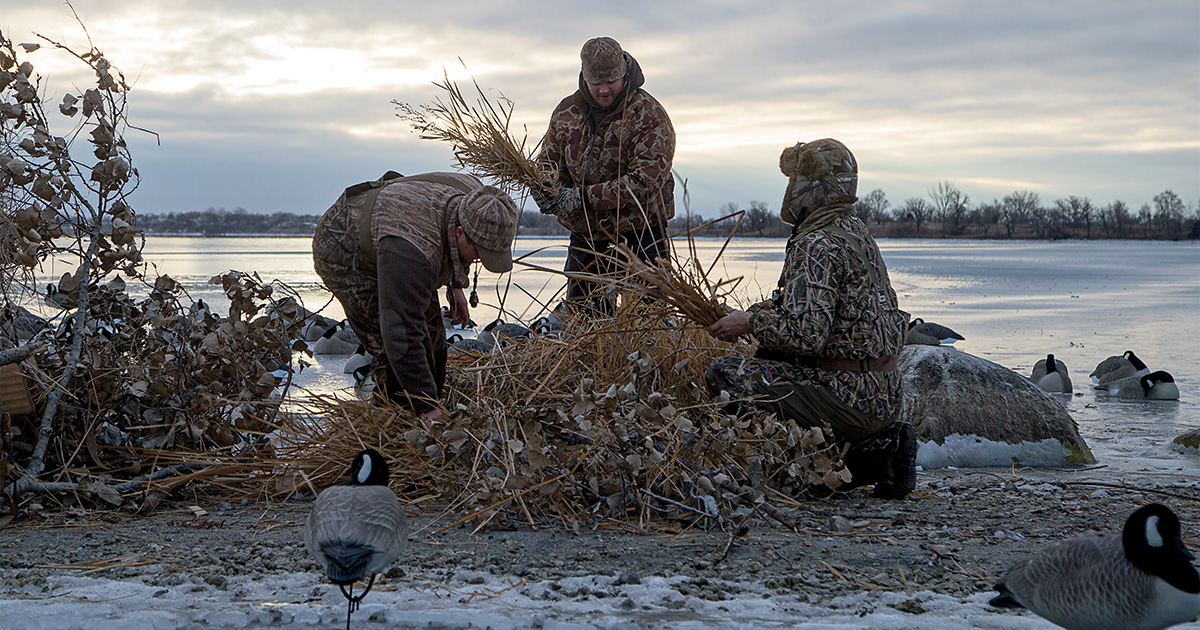Camouflaging Portable Blinds
Here’s how to conceal mobile blinds so you’ll stay hidden from the watchful eyes of waterfowl in a variety of habitats
Here’s how to conceal mobile blinds so you’ll stay hidden from the watchful eyes of waterfowl in a variety of habitats

Collect natural vegetation from the area where you’re hunting and use zip ties to attach it to the blind.
A-frames, layouts, and other portable blinds are great options for mobile hunters. They allow you to set up on the X—exactly where ducks and geese want to be. Here’s how to conceal mobile blinds so you’ll stay hidden from the watchful eyes of waterfowl in a variety of habitats.
Two of the most important steps to stay hidden in a portable blind actually take place well before the hunt. Fresh out of the box, the fabric of a portable blind will often shine in the sun, creating glare that can spook the birds, even when additional cover has been added. To tackle this problem, the fabric should be “mudded” by slapping on a mixture of dirt and water. Use a five-gallon bucket to mix up the mud and apply it with a paint brush. Once this mixture has dried, brush off excess clumps of dirt with a broom.
With the shine taken care of, the next step is to use zip ties to attach a base layer of durable synthetic grass to the straps on the blind. The zip ties will keep the bundles of grass in place throughout the season and save a lot of time when setting up before a hunt. Be sure to choose colors of grass that match the general surroundings of the areas you typically hunt.
With a base layer of synthetic grass attached, use the moments before a hunt to fill in gaps and further break up the outline of the blind using natural vegetation from the surrounding area. If there is little cover available, make use of grasses, brush, or cattails from a nearby fence line, slough edge, or even a roadside ditch. The goal is to make the blind blend into the background, so try to match the cover as closely as possible to the vegetation that surrounds the blind.
A rake, pruning shears, and battery-powered hedge trimmer can help make quick work of gathering material for the blind. Use zip ties to make extra bundles of grass that you can add to cover any trouble spots, especially the top opening of an A-frame blind, and to fill in the gaps that pop up due to the normal wear and tear of a hunt.
Having a blind that is portable means you can move quickly in response to the birds’ behavior or changes in the wind or position of the sun. When selecting where to place the blind, use any available vertical cover like taller crop stubble, grassy swales, and even fence lines to help break up the outline of the blind, even if this means moving slightly off the X. This is especially important on cloudy days, when there are no shadows to help hide the blind and waterfowl are often especially wary.
On bright, cloudless days, blinds should be positioned with the sun at your back. By taking advantage of the sun and shadows, a blind can virtually disappear, and the birds won’t be aware of your presence until it’s too late.
Ducks Unlimited uses cookies to enhance your browsing experience, optimize site functionality, analyze traffic, and deliver personalized advertising through third parties. By continuing to use this site, you agree to our use of cookies. View Privacy Policy